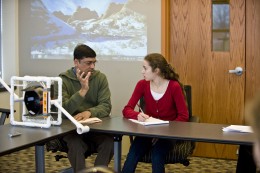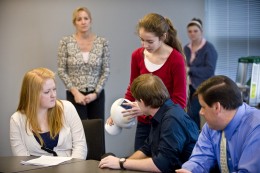When 9-year-old Jake Rowland collided with another soccer player and came crashing to the concrete-like turf that August day in Springfield, he didn’t get up. It was a heart-stopping moment for Jake’s sister, Samantha, who was videotaping the action.
Jake had suffered a concussion, which produced headaches, ended his soccer season and took him out of school for nearly two weeks.
But the concussion also ignited the scientific curiosity of sister Sammie, who made it the topic of her 8th grade science fair project in Tipp City and sent her to Wright State to pick the brains of the university ’s top head-injury researchers.

Tarun Goswami, joint associate professor of biomedical engineering and orthopaedic surgery, discusses concussion research with 8th grader Samantha Rowland.
“She seems to gravitate towards areas where she has a personal interest,” said her mother, Carrie.
So on a recent Friday at Wright State’s Joshi Research Center, professor Tarun Goswami and his team of researchers–more accustomed to briefing military officials and business executives—assembled to share their concussion research and expertise with a middle-schooler.
“Being part of a major research university doesn’t mean restricting discoveries to a select few people,” said Goswami, joint associate professor of biomedical engineering and orthopaedic surgery. “Sharing knowledge with even our youngest citizens is part of a community spirit at Wright State that fires youthful imaginations and plants the seeds for future discoveries.”
As the team of researchers presented their work to Sammie, there was a blur of references to velocities, angular acceleration, G forces and conservation of momentum. The equations were a bit intimidating for an 8th grader, but Sammie watched attentively, taking occasional notes.

Samantha Rowland explains her experiment to Wright State student researchers (left to right) Sarah Caupp, Keith Saum and Brian Yeakley.
Undergraduate researcher Isiah Kendall talked about how increased angular velocity and acceleration affect head injuries. Keith Saum discussed the importance of how quickly a collision occurs and how long it lasts. Sarah Caupp presented a timeline of injuries in the National Football League and compared the effectiveness of different helmet paddings over the years. And graduate researcher Brian Yeakley described the various ways helmets are tested.
Displayed on a table was an array of football, hockey and lacrosse helmets of varying shapes and paddings. Sammie asked about the different shapes and was intrigued by the holes in one helmet that permit the inflation of cushioning bladders.
Prior to her visit to Wright State, Sammie had been busy with her own research.
She had inserted an iPod with an accelerometer into a Styrofoam head and slipped it into a football helmet, which was tethered to a web of PVC piping. The result was a device that could measure G forces when dropped on the ground.
Sammie padded the helmet with several different materials, including pillow foam, a homemade gel consisting of water and cornstarch, and rubber heel cups used as cushions in shoes.
After stuffing the helmet with one of the paddings, she dropped it from one and two feet off the ground onto a patch of grass, a concrete paver and another helmet. She measured the impacts of five drops and then calculated the average G force.
Sammie asked the Wright State researchers how to improve her experiment, how to interpret her data, and for an analysis of the material used to make the heel cups.
“Right now, we’re conducting experiments in our basement,” said Carrie Rowland. “While that’s great for a middle-schooler, it’s important to me for her to have interact with real scientists, see what research looks like, meet graduate students and be exposed to that.”
The researchers suggested that Sammie drop the helmet from up to four feet to better simulate a fall to the ground by a player. And they told her to think about a test that would measure the angular as well as straight-line impact. They also promised to analyze the material used to make the heel cups.
Sammie’s efforts garnered her a first-place award at the science fair. She hopes her research in some small way helps prevent or minimize concussions.
“I learned a lot, especially from seeing the different types of helmets that they had here, the different paddings that they had, and them explaining to me what a concussion was and the forces about it,” Sammie said. “I’m hoping I can find that the type of padding you put in the helmet maybe does make a difference.”
Goswami said he hopes Wright State’s interaction with Sammie helps educate schoolchildren and the greater community about the dangers of concussions.
Goswami is working with QuickSeries Publishing in hopes of distributing pocket notebooks to the schools that would include a laminated page detailing conditions in which concussions occur, how to handle any trauma and when to seek professional help.

 Warm greeting
Warm greeting  Small Business Farmer’s Market celebrates spirit of entrepreneurship at Wright State
Small Business Farmer’s Market celebrates spirit of entrepreneurship at Wright State  Inaugural May Daze Craft Beer Fest at Wright State to showcase local breweries, alumni
Inaugural May Daze Craft Beer Fest at Wright State to showcase local breweries, alumni  Wright State nursing, social work students experience challenges of poverty in simulation
Wright State nursing, social work students experience challenges of poverty in simulation  Immortal exhibition
Immortal exhibition 